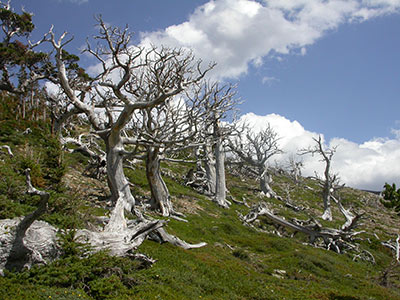Ghosts! They seem to be everywhere this time of year. Not just in the haunted houses and twilit graveyards you would expect, but in the stores, the neighbor’s yard and even at the door asking for candy!
Well, ghosts can be found in forests too. Deep in the coldest, highest elevations of the northern Rocky Mountains, where the merciless alpine winds cause trees to grow twisted and gnarled in what are called “krummholz forests,” live the ghost trees — “skeletons” of whitebark pine. Sometimes, an entire stand of ghost trees sits eerily on the mountainside.

And unlike the tots that might show up at your door in a white sheet this evening, with these ghosts, there may actually be something to fear.
That’s because what happened to these trees is a spooky prospect for these forests. The whitebark pine forests have been haunted in recent decades by a number of ominous forces. One is the mountain pine beetle. This pest is a native insect, but in recent years, its population has grown out of control. Warmer winters have allowed these beetles to live longer and climb into upper elevations and many trees have been lost. In fact, more than 41.7 million acres in more than 10 states are already dead and dying from this disease. Can you feel the chill running down your spine yet?
Another threat haunting these trees is white pine blister rust, an invasive disease. If you see a tree with green branches below and all the needles on the top red, it may be a sign of the disease. This “topkill” occurs as the blister rust attacks the tree one section at a time. Eventually, the whole tree will turn red and die.
But, there are many strategies to combat these frights and you don’t have to wear garlic around your neck or throw salt over your shoulder. American Forests is working with our partners on a strategy to save the whitebark pine. Our methods include protecting healthy whitebarks with pheromone patches to trick mountain pine beetles into avoiding the tree; collecting cones of blister rust-resistant trees to nurture into a more resilient future generation of whitebark pine; and conducting research to identify where to plant seedlings to give them the best chance of survival.

You can help by donating to the cause.
Read more about the ghost forests of the Greater Yellowstone Area in Dr. Cathy L. Cripps’ article, Underground Connection: Fungi and Pines in Peril.